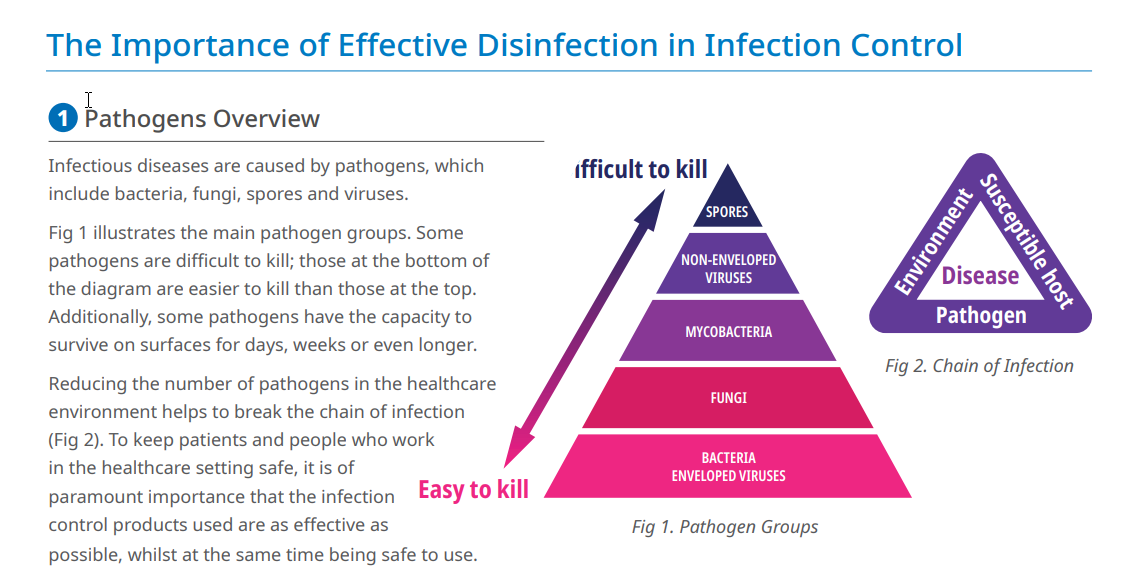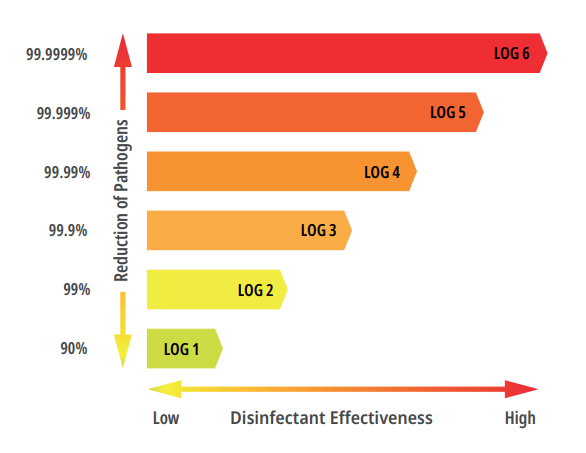Cleaning, Sanitizing, Disinfecting, and Sterilizing
This page took a lot of research, but the information gets into the specifics of each level of germ, fungus, and mold killing set by federal government standards and best practices. It applies to many products and chemicals including hypochlorous acid (HOCl), but HOCl in various strengths is the safest while meeting all standards.
VERY IMPORTANT:
HOCl is the only truly safe disinfectant. From a website: “Breathing problems. Itchy skin, rashes and burns. Irritated eyes. For some workers, including maintenance workers, janitors and housekeepers, these symptoms may have a common factor: cleaning products.”
The most common cleaning products have quaternary ammonium compounds (quats). They are not safe around kids, pets, and food.
Quats used as a sanitizer must be washed off, otherwise the residual on the dried surface is hazardous.
HOCl used as a sanitizer, and in many uses as a disinfectants does not have to be washed off.
Switch to HOCl. It’s safe enough to disinfect your mask while wearing it! With other products you have to spray, rinse, dry.
Cleaning comes first to get the dirt and grease off.
Sanitization gets the germ level down to a safe level. Disinfecting kills more pathogens. Sterilizations kills everything:
“Sanitizing is the process of reducing germs on surfaces to meet public health standards.
Sanitizing includes using a sanitizer to wipe down children’s toys in a preschool setting or to wipe down tables in a restaurant. This process has a lot in common with disinfecting, but sanitizing products need not bear an EPA registration number. Instead, in the food service industry, if the word “sanitizer” appears on a product’s label, it must meet the EPA requirement of reducing the total number of organisms by 99.999 percent within 30 seconds. If intended for use in the home, a sanitizer should kill 99.9 percent of organisms within five minutes. The individual product will specify where and how to use it for the best results.”
Disinfectants kill a wide range of bacteria, viruses, fungi, and mold at a 99.999% kill rate. 5 Minutes on the EPA SDS sheet.
Sterilization kills everything. Typically, by heat.
All disinfectants can be diluted to sanitation strength. Interestingly, HOCl can prolong freshly cut flowers at the 50 ppm level.
I haven’t found the definitive citation, but it appears that HOCl in the 100 ppm to 200 ppm range is a sanitizer. I think disinfecting occurs at 500 ppm. One Effersan tablet in a quart of water results in a high disinfectant leve of 1,300 ppm, and you can safely spray at that level. For some applications diluting to 200 ppm or 500 ppm will work just fine, and your cost per gallon goes down.
At 500 ppm the cost is about $1.50 / gallon.
At 1,300 ppm, the cost is about $3.50 /gallon
The EcoOne system is a great choice for home and office, since it can quickly produce a liter or 1.5 L, at 200 ppm for $.05/gallon.
This is running it for 2 cycles. Each additional cycle adds 80 ppm (maybe more). 280 ppm may be disinfectant level.
Here are some great links to make sense of it all, plus the procedures you need to follow:
A YouTube video that uses toy soldiers in place of bacteria: HERE
Vending Times. Great information about the classifications: HERE
Very handy cleaning chart for your wall or fridge: HERE
Effersan tablet dilution chart. Call me about ordering. HERE
The tablets are an easy way to produce HOCl in recommended strengths of 50 ppm to 1,300. Call me about ordering. There are a few choices.
HOCl from tablets vs. bleach. Not a skin irritant and non-corrosive: HERE
ADDITIONAL DEFINITIONS
“Chemical disinfectants are grouped by the types of microbes and infectious agents they are effective against.
High-level germicides kill vegetative cells, fungi, viruses, and endospores, and can ultimately lead to sterilization.
Intermediate-level germicides cannot kill all viruses and are less effective against endospores.
Low-level germicides kill vegetative cells and some enveloped viruses, but are ineffective against endospores.
The effectiveness of a disinfectant is influenced by several factors, including length of exposure, concentration of disinfectant, temperature,
When it comes to these three terms, it’s not just semantics. They’re each distinct methods of removing germs, dirt and impurities from surfaces
or objects. Braden explains it like this:
Cleaning is the physical process of removing dirt, germs, viruses and bacteria, typically using soap and water.
While it doesn’t necessarily kill germs, by removing them from surfaces and objects – including hands – you lower the risk of spreading infection.
Disinfecting uses chemicals to kill germs. While it doesn’t necessarily clean dirty surfaces or remove germs,
it kills germs and can lower the risk of spreading infection.
Sanitizing is removing and lowering numbers of germs to a safe level, as judged by public health standards.
For most of us, sanitizing, which is more about reducing the number of germs, rather than killing all of them, is the sweet spot.
“We don’t need perfectly disinfected houses,” said Braden. “We just need to remove the bulk of germs so that when we’re going about our
daily lives, we don’t have as many risk factors for getting communicable infections.”
For routine household needs, using a disinfectant is most important for bathrooms; kitchens where raw meat is handled, prepped or cooked;
and places of frequent contamination, such as doorknobs and keys, Braden said. When a member of the household is sick, using a disinfectant
is useful for all surfaces an individual may have contaminated with their germs.
› Cleaning – Physically removing all dirt and contamination, oftentimes using soap and water. The friction of cleaning removes most germs and exposes any remaining germs to the effects of a sanitizer or disinfectant used later.
› Sanitizing – Reducing germs on inanimate surfaces to levels considered safe by public health codes or regulations. Sanitizing may be appropriate for food service tables, high chairs, toys, and pacifiers.
› Disinfecting – Destroying or inactivating most germs on any inanimate object, but not bacterial spores. Disinfecting may be appropriate for diaper tables, door and cabinet handles, toilets, and other bathroom surfaces.
› Detergent – A cleaning agent that helps dissolve and remove dirt and grease from fabrics and surfaces. Soap can be considered a type of detergent.
› Dwell Time – The duration a surface must remain wet with a sanitizer/disinfectant to work effectively.
› Germs– Microscopic living things (such as bacteria, viruses, parasites and fungi) that cause disease.


The two charts are from endurocide.com
